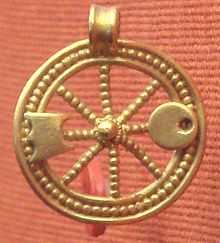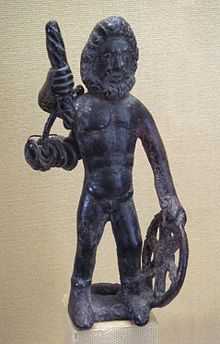Esus
Esus or Hesus was a Gaulish god known from two monumental statues and a line in Lucan's Bellum civile.
Imagery
The two statues on which his name appears are the Pillar of the Boatmen from among the Parisii and a pillar from Trier among the Treveri. In both of these, Esus is portrayed cutting branches from trees with his axe. Esus is accompanied, on different panels of the Pillar of the Boatmen, by Tarvos Trigaranus (the ‘bull with three cranes’), Jupiter, Vulcan, and other gods.
Written sources
A well-known section in Lucan's Bellum civile talks about the gory sacrifices offered to a triad of Celtic deities: Teutates, Hesus (an aspirated form of Esus), and Taranis.[1] Among a pair of later commentators on Lucan's work, one identifies Teutates with Mercury and Esus with Mars. According to the Berne Commentary on Lucan, human victims were sacrificed to Esus by being tied to a tree and flailed.[2]
The Gallic medical writer Marcellus of Bordeaux may offer another textual reference to Esus in his De medicamentis, a compendium of pharmacological preparations written in Latin in the early 5th century and the sole source for several Celtic words. The work contains a magico-medical charm decipherable as Gaulish which appears to invoke the aid of Esus (spelled Aisus) in curing throat trouble.[3]
The given name "Esunertus" ("strength of Esus") occurs at least once as an epithet of Mercury on a dedicatory inscription.[4][5] It is possible that the Esuvii of Gaul, in the area of present-day Normandy, took their name from this deity.[6]
Interpretations
MacCulloch's assessment
John Arnott MacCulloch summarized the state of scholarly interpretations of Esus in 1911 as follows:
| “ | M. Reinach applies one formula to the subjects of these altars—"The Divine Woodman hews the Tree of the Bull with Three Cranes." The whole represents some myth unknown to us, but M. D'Arbois finds in it some allusion to events in the Cúchulainn saga. In the imagery, the bull and tree are perhaps both divine, and if the animal, like the images of the divine bull, is three-horned, then the three cranes (garanus, "crane") may be a rebus for three-horned (trikeras), or more probably three-headed (trikarenos). In this case, woodman, tree, and bull might all be representatives of a god of vegetation. In early ritual, human, animal, or arboreal representatives of the god were periodically destroyed to ensure fertility, but when the god became separated from these representatives, the destruction or slaying was regarded as a sacrifice to the god, and myths arose telling how he had once slain the animal. In this case, tree and bull, really identical, would be mythically regarded as destroyed by the god whom they had once represented. If Esus was a god of vegetation, once represented by a tree, this would explain why, as the scholiast on Lucan relates, human sacrifices to Esus were suspended from a tree. Esus was worshipped at Paris and at Trèves; a coin with the name Æsus was found in England; and personal names like Esugenos, "son of Esus," and Esunertus, "he who has the strength of Esus," occur in England, France, and Switzerland. Thus the cult of this god may have been comparatively widespread. But there is no evidence that he was a Celtic Jehovah or a member, with Teutates and Taranis, of a pan-Celtic triad, or that this triad, introduced by Gauls, was not accepted by the Druids. Had such a great triad existed, some instance of the occurrence of the three names on one inscription would certainly have been found. Lucan does not refer to the gods as a triad, nor as gods of all the Celts, or even of one tribe. He lays stress merely on the fact that they were worshipped with human sacrifice, and they were apparently more or less well-known local gods.[4] | ” |
In Neo-Druidism
The 18th century Druidic revivalist Iolo Morgannwg identified Esus with Jesus on the strength of the similarity of their names. He also linked them both with Hu Gadarn, writing:
| “ | Both Hu and HUON were no doubt originally identical with the HEUS of Lactantius, and the HESUS of Lucan, described as gods of the Gauls. The similarity of the last name to IESU [Welsh: Jesus] is obvious and striking.[7] | ” |
This identification is still made in certain Neo-Druidic circles. Modern scholars consider the resemblance between the names Esus and Jesus to be coincidental.
See also
References
- ↑ M. Annaeus Lucanus (61-65 CE). Bellum civile I.445.
- ↑ Mary Jones (2005). Jones' Celtic Encyclopedia
- ↑ De medicamentis 15.106, p. 121 in Niedermann's edition; Gustav Must, “A Gaulish Incantation in Marcellus of Bordeaux,” Language 36 (1960) 193–197; Pierre-Yves Lambert, “Les formules de Marcellus de Bordeaux,” in La langue gauloise (Éditions Errance 2003), p.179, citing Léon Fleuriot, “Sur quelques textes gaulois,” Études celtiques 14 (1974) 57–66.
- ↑ 4.0 4.1 J. A. MacCulloch (1911). ‘Chapter III. The Gods of Gaul and the Continental Celts.’ The Religion of the Ancient Celts. New York: Dover Publications. ISBN 0-486-42765-X.
- ↑ Cf. also Mary Jones' "Examples of Interpretatio Romana"
- ↑ Jan de Vries (1954). Keltische Religion. W. Kohlhammer, Stuttgart. p.98. Cited here.
- ↑ Iolo Morganwg (1862, ed. J. Williams Ab Ithel). The Barddas of Iolo Morganwg, Vol. I.
External links
- Esus, including photographs and a capitulation of primary and secondary source material.
- A contemporary Dutch-language story of struggle between Esus and Tarvos Trigaranus

